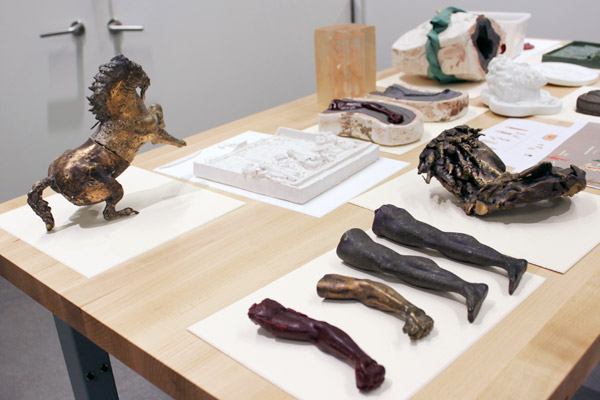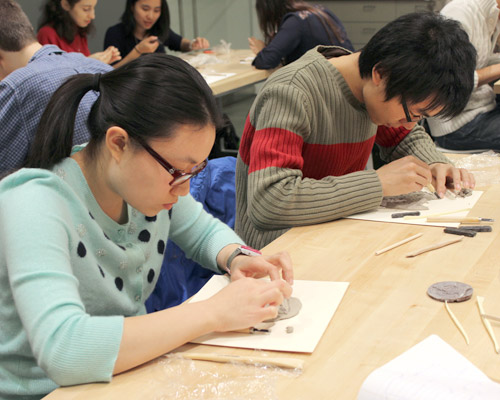Fifteen Harvard freshmen recently attended a workshop in the Harvard Art Museums’ Materials Lab (M/Lab), where they learned about plaster cast sculptures by making their own.
The hands-on workshop was among the first held at the M/Lab, a space for active looking and exploration of art and art materials. Organized in partnership with the Freshman Dean’s Office, the event was a chance for the newest members of Harvard’s community to better acquaint themselves with the museums and the diverse learning experiences that the collections can offer.
With a rotating calendar of workshops and seminars open to the public, the M/Lab encourages visitors to examine and better understand artists’ choices of materials, techniques, processes, and more, through direct engagement with those subjects. It also gives insight into the work of conservators in the museums’ Straus Center for Conservation and Technical Studies, who must frequently interpret and make important decisions about how to conserve objects.
“In the M/Lab we ask questions like: What kinds of choices and challenges do materials and techniques pose for artists as well as scholars and conservators?” said Francesca Bewer, the museums’ research curator for conservation and technical studies programs. “And how does a more nuanced appreciation of art-making impact the aesthetic experience?”
Bewer kicked off the freshman workshop by providing an overview of the plaster casting technique, in which a “negative” design is formed in malleable material like clay by pressing, drawing, modeling, and other actions, and then plaster slurry (a thick mixture of plaster and water) is poured on top. Ultimately, the set plaster bears the inverse, or positive version, of the malleable material’s design.
Variations on this technique have been used for centuries, across many cultures, to produce art of different sizes, shapes, and styles, Bewer explained. Plaster casts were often used in the 19th and early 20th century to make reproductions of sculptures for display in museums, including Harvard’s. Plaster cast reproductions of Germanic medieval monuments can still be seen in Adolphus Busch Hall today.
The students visited the galleries to look at examples of work created with casts before creating their own: they observed the striking texture of Rosemarie Trockel’s ceramic Shutter (c) (2006), for example, which came from slashing and impressing fresh clay against a large mass of raw meat. They also spent some time with ancient Chinese bronzes (such as this ritual wine vessel) bearing intricate patterns. Students made observations about the appearance and texture of these vastly different works, and Bewer challenged them to think about how they would make them.
For many students, that was no easy task. But back in the M/Lab, as they kneaded fresh clay, the concept seemed less foreign.
Students first flattened the clay into round or rectangular slabs. Then, using a variety of textured tools, stamps, and drawing implements, they made impressions in and added extra elements to the clay. Finally, they added a short barrier of clay around the edges to contain the fresh plaster slurry that was poured onto the newly wrought designs.
“I have so much more respect for artists now that I realize all the details they have to consider,” said student Samuel Huang ’18, after he covered his clay mold with plaster. He chose to reproduce the Harvard seal, having to carefully inscribe “VERITAS” because the design’s inverse would ultimately be shown in the plaster.
His peer Flavia Cuervo ’18 said the experience immediately led her to see the sculptures in the gallery in a new light. “It’s nice to think of the backstory of these objects, of how they were made,” she said.
That type of behind-the-scenes, experiential knowledge is exactly what the museums hope visitors will gain from the M/Lab. Future public programming will cover other materials, such as pigments, as well as fresco-making techniques and tempera panel painting.





